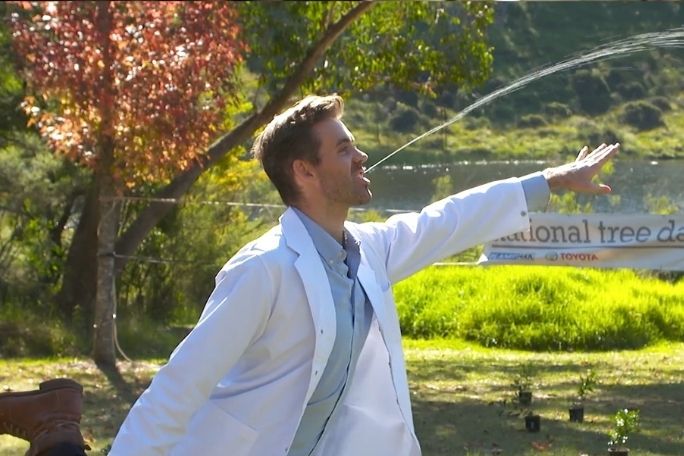Lesson summary
A new report by Planet Ark has revealed that time spent in nature has amazing benefits for our health and wellbeing. In this lesson students will watch a short video to find out what some of the benefits are and analyse how the message of the video is conveyed. Students critically assess their own activities on an average day and consider ways that they could spend more time in nature. Students then apply their understanding of the issue to the creation of their own short video that advocates the health and wellbeing benefits of time in nature. Teachers are encouraged to share the videos with Planet Ark.
Learning intentions:
Students will...
- understand the effect of spending time in nature on their health
- identify actions and activities that could improve their own wellbeing
- recognise the relationship between health, wellbeing and time spent in nature
- recognise time spent in nature as a self-care strategy, and share their strategies with an audience.
Lesson guides and printables
Curriculum links
Select your curriculum from the options below.
Lesson details
Curriculum mapping
Australian curriculum content descriptions:
Year 7 English:
- Identify and discuss main ideas, concepts and points of view in spoken texts to evaluate qualities, for example the strength of an argument or the lyrical power of a poetic rendition (ACELY1719)
- Analyse and explain the ways text structures and language features shape meaning and vary according to audience and purpose (ACELY1721)
- Plan, draft and publish imaginative, informative and persuasive texts, selecting aspects of subject matter and particular language, visual, and audio features to convey information and ideas (ACELY1725)
- Use a range of software, including word processing programs, to confidently create, edit and publish written and multimodal texts (ACELY1728)
Year 8 English:
- Interpret the stated and implied meanings in spoken texts, and use evidence to support or challenge different perspectives (ACELY1730)
- Analyse and evaluate the ways that text structures and language features vary according to the purpose of the text and the ways that referenced sources add authority to a text (ACELY1732)
- Create imaginative, informative and persuasive texts that raise issues, report events and advance opinions, using deliberate language and textual choices, and including digital elements as appropriate (ACELY1736)
Year 9 English:
- Listen to spoken texts constructed for different purposes, for example to entertain and to persuade, and analyse how language features of these texts position listeners to respond in particular ways (ACELY1740)
- Interpret, analyse and evaluate how different perspectives of issue, event, situation, individuals or groups are constructed to serve specific purposes in texts (ACELY1742)
- Create imaginative, informative and persuasive texts that present a point of view and advance or illustrate arguments, including texts that integrate visual, print and/or audio features (ACELY1746)
Year 10 English:
- Analyse and evaluate how people, cultures, places, events, objects and concepts are represented in texts, including media texts, through language, structural and/or visual choices (ACELY1749)
- Choose a reading technique and reading path appropriate for the type of text, to retrieve and connect ideas within and between texts (ACELY1753)
- Create sustained texts, including texts that combine specific digital or media content, for imaginative, informative, or persuasive purposes that reflect upon challenging and complex issues (ACELY1756)
Year 7 & 8 Health and Physical Education:
- Plan and implement strategies for connecting to natural and built environments to promote the health and well being of their communities (ACPPS078)
Year 9 & 10 Health and Physical Education:
- Plan and evaluate new and creative interventions that promote their own and others’ connection to community and natural and built environments (ACPPS097)
General capabilities: Critical and creative thinking, Personal and social capability, ICT Capability.
Cross-curriculum priority: Sustainability OI.2.
Time required: 120 minutes
Level of teacher scaffolding: Medium – oversee activity and assist with creating short film.
Resources required
- Student Worksheet – one copy per student OR computers/tablets to access the online worksheet
- Phone/tablet/camera to film short video, computer/device with video editing software
- Chalk-Talk visible thinking tool, How to make a short film help sheet, Average daily activity record, Storyboard template, Peer assessment rubric – Film
Additional info
Following this lesson is an ideal way for students to participate in Planet Ark’s Schools Tree Day – the largest nature-care event in Australian schools. You and your students will join thousands of amazing teachers in making a difference, fostering a child’s love of nature and creating positive environmental change. So, get growing! It only takes a minute to register for Schools Tree Day.


Welcome back!
Don't have an account yet?
Log in with:
Create your free Cool.org account.
Many of our resources are free, with an option to upgrade to Cool+ for premium content.
Already have an account?
Sign up with:
By signing up you accept Cool.org's Terms and Conditions(Opens in new tab) and Privacy Policy(Opens in new tab).